Live
- Mercedes-Benz India to Launch 8 New Models, Focus on EVs in 2025
- Collector Inspects EVM Godown in Nagarkurnool
- Sri Ranganatha Swamy Temple in Sripuram Prepares for Vaikunta Ekadashi
- Devotees' Tragic Demise in Tirumala Stampede: Chakravarthy Acharyulu Expresses Deep Condolences
- Aarogyasri Services to Continue Uninterrupted in Hyderabad
- Disability can be identified and prevented in the early stages -DMHO Dr. K.V. Swarajya Lakshmi
- Ram Charan's 'Game Changer' Set for Big Box Office Debut
- Scientists Provide Training to Farmers on Integrated Farming
- Kerala Man Held in Mangaluru for ₹10.32 Lakh Cyber Fraud
- SP Gaikwad Launches Feedback QR Code Poster for Police Services Opinion
Just In
LignoSat: First Wooden Satellite Launches to Orbit for Sustainability


LignoSat: First Wooden Satellite Launches to Orbit for Sustainability
LignoSat, the world’s first wooden satellite, orbits Earth to explore sustainable materials and reduce space debris. A pioneering mission by Kyoto University.
The LignoSat, the first-ever wooden satellite, has officially entered Earth's orbit, marking a significant milestone in space technology. Launched last month as part of a five-satellite CubeSat mission, LignoSat now orbits at an altitude of approximately 400 kilometers above Earth. The satellite was deployed to the International Space Station (ISS) in November 2024 via a SpaceX Dragon capsule, where it began its mission to explore the potential of sustainable materials in space.
LignoSat, which weighs just 900 grams, is constructed primarily from magnolia wood, with panels measuring 10 centimeters in size. The satellite's unique design features traditional Japanese joinery, utilizing the Blind Miter Dovetail Joint technique to connect its wooden panels. This method eliminates the need for screws or adhesives, showcasing an eco-friendly approach to satellite construction. By using sustainable materials like wood, LignoSat represents a potential breakthrough in reducing the environmental impact of space technology.
The mission aims to assess the performance of wood in the harsh conditions of space. Researchers at Kyoto University, who are spearheading the project, hope that the findings will provide valuable insights into the durability of wood as an alternative to more conventional materials like aluminum and titanium, which are commonly used in satellite construction.
LignoSat's onboard sensors are designed to monitor how the wooden satellite reacts to the extreme temperatures of space, ranging from -100°C to 100°C every 45 minutes. In addition to temperature fluctuations, the satellite will also measure the effects of geomagnetic fields on the wood. These data points will provide a deeper understanding of the material's resilience in the unforgiving environment of space.
One of the most exciting aspects of the LignoSat mission is its potential to address the growing problem of space debris. Unlike traditional satellites, which leave behind lasting remnants upon re-entry, wooden satellites like LignoSat are expected to burn up completely during re-entry, leaving no debris behind. This makes wooden satellites a promising solution for reducing space junk.
Kyoto University, which is at the forefront of this innovative project, believes that wooden satellites could play a key role in future space missions. Astronaut Takao Doi, who is involved in the research, has highlighted the potential of wood for space habitats. “Timber could be used to construct homes and workspaces in space,” Doi said, highlighting the material's versatility and resilience. With no need for water or oxygen, wood’s unique properties make it an appealing choice for building structures in space.
LignoSat's mission aligns with the growing trend of sustainable space technology. By exploring the potential of wooden satellites, Kyoto University is contributing to the development of eco-friendly solutions for space exploration, ensuring that future missions can be both technologically advanced and environmentally responsible.
As LignoSat continues to orbit Earth, it will provide valuable data that could reshape the future of space technology. The satellite's mission not only paves the way for using sustainable materials in space but also offers a glimpse into how space debris might be reduced in the coming years. With its innovative design and groundbreaking research, LignoSat is all set to make a lasting impact on the way we approach space exploration and environmental sustainability.

© 2025 Hyderabad Media House Limited/The Hans India. All rights reserved. Powered by hocalwire.com






